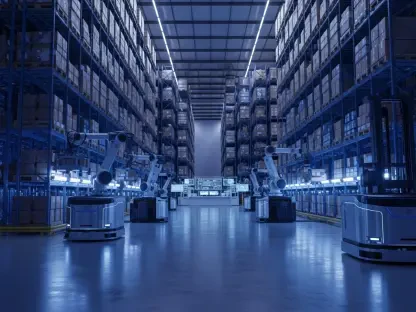The synthetic viscose fiber industry stands at a pivotal moment, with projections estimating a remarkable climb to a $37.4 billion valuation by 2034, driven by a steady compound annual growth rate (CAGR) of 7% from the current $19.0 billion base in 2025. This growth trajectory reflects a burgeoning demand for affordable and eco-friendly textile materials across diverse sectors like apparel, medical products, and automotive interiors. As sustainability becomes a cornerstone of consumer and corporate decision-making, viscose fiber—known for its biodegradable nature and silk-like feel—emerges as a frontrunner in meeting these needs. Yet, the path forward is not without hurdles, as environmental concerns and geopolitical tensions cast shadows over production and supply chains. Delving into the factors propelling this market, alongside the challenges that could temper its ascent, offers a clearer picture of what lies ahead for this dynamic sector.
Driving Forces Behind Market Expansion
Rising Demand for Sustainable Textiles
The surge in demand for sustainable textiles represents a key driver propelling the synthetic viscose fiber market toward its ambitious growth targets over the next decade. With global awareness of environmental issues on the rise, consumers and industries alike are gravitating toward materials that offer both functionality and a reduced ecological footprint. Viscose fiber, derived from renewable sources like wood pulp, fits this criterion due to its biodegradability and ability to blend seamlessly with other fibers. Its applications span a wide range, from everyday apparel to specialized uses in hygiene products and home furnishings. Notably, the push for greener alternatives in fashion, where fast-paced trends often lead to waste, has positioned viscose as a viable solution. This trend is particularly pronounced in emerging economies, where rising disposable incomes and urbanization fuel textile consumption, creating a robust market for affordable yet sustainable options.
Beyond consumer preferences, corporate responsibility plays a significant role in this shift toward sustainability within the textile industry. Many companies are adopting eco-conscious practices, driven by both market demand and regulatory pressures, to incorporate materials like viscose into their product lines. Innovations such as closed-loop production systems, which minimize waste and recycle resources, further enhance the appeal of this fiber. These advancements not only address environmental concerns but also improve cost-efficiency over time, making viscose a strategic choice for manufacturers. Additionally, the versatility of the material allows it to penetrate niche markets, such as medical textiles for bandages and wipes, where its soft texture and absorbency are highly valued. As industries continue to prioritize green solutions, the alignment of viscose fiber with these goals ensures its relevance and sustained demand through 2034.
Growth in Diverse Applications
Another critical factor boosting the market is the expanding array of applications for synthetic viscose fiber across multiple industries. While apparel remains a dominant sector, the material’s unique properties—such as its lightweight structure and compatibility with various finishes—make it ideal for home textiles like curtains and bedding, as well as industrial uses including tire cords and filtration systems. The automotive sector, in particular, has seen a growing integration of viscose in interior components, where durability and aesthetics are equally important. This broadening scope of use underscores the fiber’s adaptability, positioning it as a go-to material for manufacturers seeking innovative solutions to meet evolving market needs.
Equally significant is the role of specialized applications in driving market growth, especially in the medical and hygiene sectors. Viscose fiber’s hypoallergenic and moisture-absorbent qualities make it a preferred choice for products like surgical dressings, masks, and disposable wipes, areas that have seen heightened demand in recent years due to global health concerns. As technology advances, the potential for further innovation in these fields grows, opening new revenue streams for industry players. The ability of viscose to cater to such varied demands, from everyday consumer goods to critical healthcare items, highlights its economic importance. With ongoing research into enhancing its properties, the material is likely to find even more applications by 2034, solidifying its place in a competitive landscape.
Challenges and Market Constraints
Environmental and Regulatory Pressures
Despite its promising growth, the synthetic viscose fiber market faces substantial challenges tied to the environmental impact of its production processes. The manufacturing of viscose involves chemical-intensive methods that can harm ecosystems if not managed properly, particularly through the use of wood pulp as a primary raw material. Concerns over deforestation and water pollution have led to stricter regulations in key producing regions like China and Europe, often resulting in temporary production halts and supply chain disruptions. These environmental considerations not only affect operational costs but also influence public perception, as stakeholders demand greater accountability from manufacturers in adopting sustainable practices.
Compounding these issues are the regulatory frameworks that vary significantly across regions, creating a complex landscape for global players in the viscose market. Compliance with stringent environmental standards often requires significant investment in cleaner technologies, which can strain smaller producers and lead to price volatility. Additionally, the reliance on raw materials susceptible to geopolitical disruptions adds another layer of risk. For instance, fluctuations in wood pulp availability due to trade policies or regional conflicts can directly impact production timelines and costs. Addressing these environmental and regulatory challenges remains critical for the industry to maintain its growth momentum while aligning with global sustainability goals through the coming years.
Economic and Geopolitical Instabilities
Economic uncertainties and geopolitical tensions further complicate the outlook for the synthetic viscose fiber market, posing risks to its projected expansion. Global economic slowdowns and inflationary pressures have dampened consumer spending on non-essential goods like apparel and home textiles, directly affecting demand. Rising costs of raw materials and energy, often exacerbated by international conflicts, have also driven up production expenses, squeezing profit margins for manufacturers. These economic headwinds create a cautious environment for investment in the sector, as companies grapple with balancing growth ambitions against financial constraints.
On the geopolitical front, trade disputes and supply chain disruptions continue to challenge market stability, particularly given the heavy reliance on specific regions for production. Tariffs and trade barriers between major economies can disrupt the flow of raw materials and finished goods, leading to delays and increased costs. Such instabilities highlight the vulnerability of the industry to external shocks, necessitating strategic planning to mitigate risks. As the market evolves toward 2034, navigating these economic and geopolitical dynamics will be essential for stakeholders aiming to capitalize on growth opportunities while maintaining operational resilience.
Looking Ahead to Sustainable Solutions
Innovations Shaping the Future
Reflecting on the journey of the synthetic viscose fiber market, it becomes evident that innovation plays a pivotal role in addressing past challenges and setting a foundation for future growth. Investments in greener technologies, such as closed-loop systems and the use of recycled raw materials, demonstrate a commitment to reducing the environmental footprint of production. These advancements not only meet regulatory demands but also resonate with a consumer base increasingly focused on sustainability. By tackling ecological concerns head-on, the industry manages to maintain its appeal across diverse applications, from fashion to healthcare, ensuring a steady demand trajectory.
Strategic Steps for Long-Term Growth
Looking back, the path to a $37.4 billion valuation by 2034 was underpinned by strategic adaptations to economic and geopolitical challenges. The focus on diversifying supply chains and exploring alternative raw materials proved essential in mitigating risks from global disruptions. Moving forward, stakeholders are encouraged to deepen collaborations with technology providers to enhance production efficiency and sustainability. Prioritizing research into new applications and markets, particularly in emerging economies, offers a way to sustain momentum. Additionally, fostering transparent communication with regulators and consumers about environmental efforts can build trust and strengthen market position. These actionable steps pave the way for a resilient and thriving future in this evolving industry.









